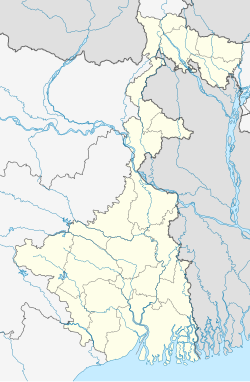Dakshin Khagrabari is a census town in the Maynaguri CD block in the Jalpaiguri Sadar subdivision of the Jalpaiguri district in the state of West Bengal, India.
Dakshin Khagrabari | |
|---|---|
Census Town | |
| Coordinates: 26°33′19″N 88°50′17″E / 26.5554°N 88.8381°E | |
| Country | |
| State | West Bengal |
| District | Jalpaiguri |
| Area | |
• Total | 4.3598 km2 (1.6833 sq mi) |
| Population (2011) | |
• Total | 7,469 |
| • Density | 1,700/km2 (4,400/sq mi) |
| Time zone | UTC+5:30 (IST) |
| PIN | 735224 |
| Telephone/STD code | 03561 |
| Vehicle registration | WB |
| Lok Sabha constituency | Jalpaiguri |
| Vidhan Sabha constituency | Maynaguri |
| Website | jalpaiguri |
Geography
edit10miles
River
Wildlife
Sanctuary
National
Park
checkpoint
CT: census town, R: rural/ urban centre, N: neighbourhood, C: cantonment, NP: national park/ wildlife sanctuary, TE: tea estate
Abbreviations used in names – TG for Tea Garden (town/village), TE for Tea Estate, JRS: junction railway station
Owing to space constraints in the small map, the actual locations in a larger map may vary slightly
Location
editDakshin Khagrabari is located at 26°33′19″N 88°50′17″E / 26.5554°N 88.8381°E.
Area overview
editThe map alongside shows the alluvial floodplains south of the outer foothills of the Himalayas. The area is mostly flat, except for low hills in the northern portions.[1][2] It is a primarily rural area with 62.01% of the population living in rural areas and a moderate 37.99% living in the urban areas.[3][4] Tea gardens in the Dooars and Terai regions produce 226 million kg or over a quarter of India's total tea crop.[5][6] Some tea gardens were identified in the 2011 census as census towns or villages.[7] Such places are marked in the map as CT (census town) or R (rural/ urban centre). Specific tea estate pages are marked TE.
Note: The map alongside presents some of the notable locations in the subdivision. All places marked in the map are linked in the larger full screen map.
Demographics
editAccording to the 2011 Census of India, Dakshin Khagrabari had a total population of 7,469 of which 3,786 (51%) were males and 3,683 (49%) were females. There were 797 persons in the age range of 0 to 6 years. The total number of literate people in Dakshin Khagrabari was 5,108 (76.56% of the population over 6 years).[8]
Infrastructure
editAccording to the District Census Handbook 2011, Jalpaiguri, Dakshin Khagrabari covered an area of 4.3598 km2. Among the civic amenities, it had 21.5 km roads, the protected water supply involved tube well, bore well, uncovered wells. It had 879 domestic electric connections, 78 road lighting points. Among the medical facilities it had 1 family welfare centre, 1 maternity and child welfare unit. Among the educational facilities it had 4 primary schools, 1 secondary schools, the nearest senior secondary school at Mainaguri 1 km away. It had 4 non-formal education centres (Sarva Shiksha Abhiyan), 1 special school for the disabled. It had branch of 1 agricultural credit society.[9]
References
edit- ^ Debnath, S. (2010). The Dooars in Historical Transition (PDF). Shiv Mandir: N. L. Publishers.
- ^ Dinerstein, E., Loucks, C. (2001). "Terai-Duar savanna and grasslands". Terrestrial Ecoregions. World Wildlife Fund.
- ^ "Jalpaiguri". District Profile. District administration. Retrieved 13 July 2020.
- ^ "District Statistical Handbook 2014 Jalpaiguri". Tables 2.2, 2.4b. Department of Planning and Statistics, Government of West Bengal. Archived from the original on 21 January 2019. Retrieved 13 July 2020.
- ^ "Tea Growing Regions". Dooars and Terai. Indian Tea Association. Retrieved 13 July 2020.
- ^ "Dooars-Terai". Tea Board India. Retrieved 13 July 2020.
- ^ "2011 Census – Primary Census Abstract Data Tables". West Bengal – District-wise. Registrar General and Census Commissioner, India. Retrieved 13 July 2020.
- ^ "2011 Census – Primary Census Abstract Data Tables". West Bengal – District-wise. Registrar General and Census Commissioner, India. Retrieved 2 July 2020.
- ^ "District Census Handbook Jalpaiguri, Census of India 2011, Series 20, Part XII A" (PDF). Section II Town Directory, Pages 451-453: Statement I: Status and Growth History, Pages 454-455: Statement II: Physical Aspects and Location of Towns, Pages 456-457: Statement III: Civic and other Amenities, Pages 458-459: Statement IV: Medical Facilities 2009, Pages 460—463: Statement V: Educational, Recreational and Cultural Facilities, Pages 464: Statement VI:Industry and Banking. Directorate of Census Operations V, West Bengal. Retrieved 26 June 2020.

